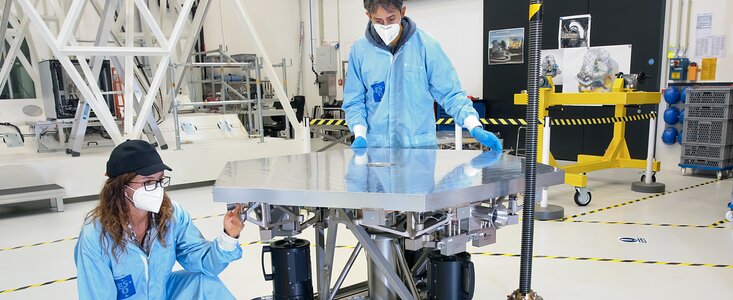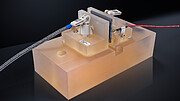Annonce
Design achievements for actuators and sensors of the main mirror of ESO's ELT
24 novembre 2020
M1, the main mirror of ESO’s Extremely Large Telescope (ELT), is moving closer to completion with the approval of the final design for its edge sensors, with its positions actuators also nearing this key milestone. The sensors and actuators are crucial to the optical quality and functionality of the giant 39-metre mirror. The ELT is planned to start operating later this decade in the Chilean Atacama Desert.
The primary mirror on the ELT, M1, is composed of 798 hexagonal segments, made of a thin glass-ceramic material. To ensure the optical quality of the mirror, its segments have to work together to maintain the mirror’s shape, despite changes in the telescope's position and in external conditions, such as temperature, pressure and wind. Movable supports and sensors for the mirror, namely the M1 position actuators and edge sensors, allow each mirror segment to move independently and with nanometric (1 millionth of a millimetre) precision and are crucial for the telescope to achieve its potential.
M1 position actuators
Lying underneath each of the 798 mirror segments, the M1 segment supports connect each mirror to the primary mirror support cell. The first set of M1 segment supports, which are being produced and tested to high precision by VDL ETG Projects BV in the Netherlands, was recently delivered to Safran Reosc in Poitiers, France, where the mirror segments are being polished and assembled.
Once in Chile, each individual mirror segment, some 1.4 metres across and weighing about 250 kg with its support structure, will be installed on three position actuators. These actuators constantly adjust the position of the mirror segments through tiny, precise movements.
The position actuators are built by the German company Physik Instrumente (PI). Specialising in precision motoring and positioning, the company will produce the required 2394 position actuators to adjust the segments of the ELT’s main mirror with pinpoint accuracy. The final design for these high-precision actuators is now nearing approval, with series manufacturing starting once the final design review is completed.
M1 edge sensors
Another important component of the main mirror system, the edge sensors, has already passed its final design review. The M1 edge sensors, which are being designed and manufactured by the FAMES consortium (comprising Fogale Nanotech in France and Micro-Epsilon in Germany), are the most precise edge sensors ever designed for a telescope. Two on each side of each segment, the sensors can detect when the segments move out of position, even if only by a millionth of a millimetre. A total of 4608 edge sensors will measure the relative positions of all M1 segments, allowing the overall shape of the mirror to be corrected when the segments move out of place.
Given the high number of edge sensors and position actuators, a consequence of the size of the ELT, the final design phase required the companies to produce dozens of units to carefully test and validate not only the products themselves, but also their manufacturing and production processes. With the completion of the final design review for the edge sensors, FAMES will begin in-series production of these crucial components of the telescope.
In mid 2021, the first batch of edge sensors and position actuators is anticipated to be delivered to the ELT Technical Facility in the Chilean Atacama Desert for future assembly into the M1 segments.
Liens
Contacts
Marc Cayrel
ESO
Garching bei München, Germany
Tel: +49 89 3200 6685
Email: mcayrel@eso.org
Bárbara Ferreira
ESO Public Information Officer
Garching bei München, Germany
Tel: +49 89 3200 6670
Cell: +49 151 241 664 00
Email: pio@eso.org
À propos de l'annonce
| Identification: | ann20032 |
Our use of Cookies
We use cookies that are essential for accessing our websites and using our services. We also use cookies to analyse, measure and improve our websites’ performance, to enable content sharing via social media and to display media content hosted on third-party platforms.
ESO Cookies Policy
The European Organisation for Astronomical Research in the Southern Hemisphere (ESO) is the pre-eminent intergovernmental science and technology organisation in astronomy. It carries out an ambitious programme focused on the design, construction and operation of powerful ground-based observing facilities for astronomy.
This Cookies Policy is intended to provide clarity by outlining the cookies used on the ESO public websites, their functions, the options you have for controlling them, and the ways you can contact us for additional details.
What are cookies?
Cookies are small pieces of data stored on your device by websites you visit. They serve various purposes, such as remembering login credentials and preferences and enhance your browsing experience.
Categories of cookies we use
Essential cookies (always active): These cookies are strictly necessary for the proper functioning of our website. Without these cookies, the website cannot operate correctly, and certain services, such as logging in or accessing secure areas, may not be available; because they are essential for the website’s operation, they cannot be disabled.
Functional Cookies: These cookies enhance your browsing experience by enabling additional features and personalization, such as remembering your preferences and settings. While not strictly necessary for the website to function, they improve usability and convenience; these cookies are only placed if you provide your consent.
Analytics cookies: These cookies collect information about how visitors interact with our website, such as which pages are visited most often and how users navigate the site. This data helps us improve website performance, optimize content, and enhance the user experience; these cookies are only placed if you provide your consent. We use the following analytics cookies.
Matomo Cookies:
This website uses Matomo (formerly Piwik), an open source software which enables the statistical analysis of website visits. Matomo uses cookies (text files) which are saved on your computer and which allow us to analyze how you use our website. The website user information generated by the cookies will only be saved on the servers of our IT Department. We use this information to analyze www.eso.org visits and to prepare reports on website activities. These data will not be disclosed to third parties.
On behalf of ESO, Matomo will use this information for the purpose of evaluating your use of the website, compiling reports on website activity and providing other services relating to website activity and internet usage.
Matomo cookies settings:
Additional Third-party cookies on ESO websites: some of our pages display content from external providers, e.g. YouTube.
Such third-party services are outside of ESO control and may, at any time, change their terms of service, use of cookies, etc.
YouTube: Some videos on the ESO website are embedded from ESO’s official YouTube channel. We have enabled YouTube’s privacy-enhanced mode, meaning that no cookies are set unless the user actively clicks on the video to play it. Additionally, in this mode, YouTube does not store any personally identifiable cookie data for embedded video playbacks. For more details, please refer to YouTube’s embedding videos information page.
Cookies can also be classified based on the following elements.
Regarding the domain, there are:
- First-party cookies, set by the website you are currently visiting. They are stored by the same domain that you are browsing and are used to enhance your experience on that site;
- Third-party cookies, set by a domain other than the one you are currently visiting.
As for their duration, cookies can be:
- Browser-session cookies, which are deleted when the user closes the browser;
- Stored cookies, which stay on the user's device for a predetermined period of time.
How to manage cookies
Cookie settings: You can modify your cookie choices for the ESO webpages at any time by clicking on the link Cookie settings at the bottom of any page.
In your browser: If you wish to delete cookies or instruct your browser to delete or block cookies by default, please visit the help pages of your browser:
Please be aware that if you delete or decline cookies, certain functionalities of our website may be not be available and your browsing experience may be affected.
You can set most browsers to prevent any cookies being placed on your device, but you may then have to manually adjust some preferences every time you visit a site/page. And some services and functionalities may not work properly at all (e.g. profile logging-in, shop check out).
Updates to the ESO Cookies Policy
The ESO Cookies Policy may be subject to future updates, which will be made available on this page.
Additional information
For any queries related to cookies, please contact: pdprATesoDOTorg.
As ESO public webpages are managed by our Department of Communication, your questions will be dealt with the support of the said Department.



